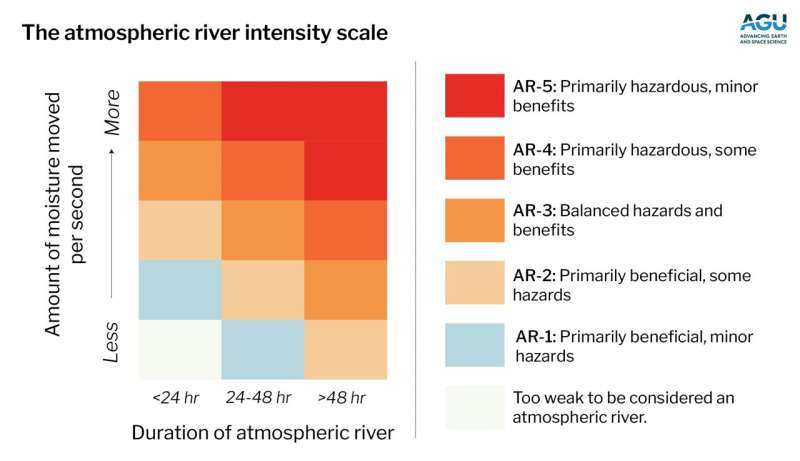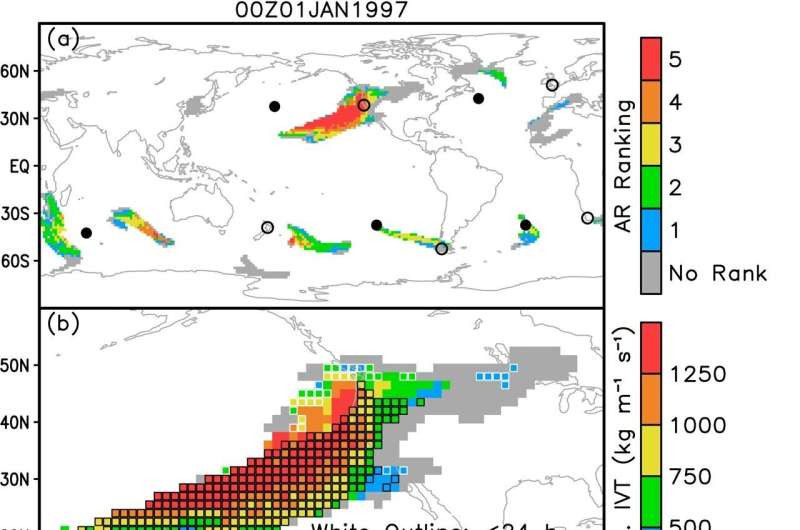This article has been reviewed according to Science X's editorial process and policies. Editors have highlighted the following attributes while ensuring the content's credibility:
fact-checked
peer-reviewed publication
trusted source
proofread
The world's atmospheric rivers now have an intensity ranking like hurricanes

Atmospheric rivers, which are long, narrow bands of water vapor, are becoming more intense and frequent with climate change. A new study demonstrates that a recently developed scale for atmospheric river intensity (akin to the hurricane scale) can be used to rank atmospheric rivers and identify hotspots of the most intense atmospheric rivers not only along the U.S. West Coast but also worldwide.
The study is published in the Journal of Geophysical Research: Atmospheres.
Atmospheric rivers typically form when warm temperatures create moist packets of air, which strong winds then transport across the ocean; some make landfall. The intensity scale ranks these atmospheric rivers from AR-1 to AR-5 (with AR-5 being the most intense) based on how long they last and how much moisture they transport.
In part because some West Coast weather outlets are using the intensity scale, "atmospheric river" is no longer an obscure meteorological term but brings sharply to mind unending rain and dangerous flooding, the authors said. The string of atmospheric rivers that hit California in December and January, for instance, at times reached AR-4. Earlier in 2022, the atmospheric river that contributed to disastrous flooding in Pakistan was an AR-5, the most damaging, most intense atmospheric river rating.
The scale helps communities know whether an atmospheric river will bring benefit or cause chaos: The storms can deliver much-needed rain or snow, but if they're too intense, they can cause flooding, landslides and power outages, as California and Pakistan experienced. The most severe atmospheric rivers can cause hundreds of millions of dollars of damage in days in the western U.S.; damage in other regions has yet to be comprehensively assessed.
"Atmospheric rivers are the hurricanes of the West Coast when it comes to the public's situational awareness," said F. Martin Ralph, an atmospheric scientist at Scripps Institution of Oceanography and a co-author on the new study. People need to know when they're coming, have a sense for how extreme the storm will be, and know how to prepare, he said. "This scale is designed to help answer all those questions."
Ralph and his colleagues originally developed the scale for the U.S. West Coast. The new study demonstrates that atmospheric river events can be directly compared globally using the intensity scale, which is how the researchers identified where the most intense events (AR-5) form and fizzle out, and how many of those make landfall.

The researchers used climate data and their previously developed algorithm for identifying and tracking atmospheric rivers to build a database of intensity-ranked atmospheric river events around the globe over 40 years (1979/1980 to 2019/2020). The study was published in the Journal of Geophysical Research: Atmospheres, .
"This study is a first step toward making the atmospheric river scale a globally useful tool for meteorologists and city planners," said Bin Guan, an atmospheric scientist at the Joint Institute for Regional Earth System Science and Engineering, a collaboration between University of California-Los Angeles and NASA's Jet Propulsion Laboratory, who led the study. "By mapping out the footprints of each atmospheric river rank globally, we can start to better understand the societal impacts of these events in many different regions."
The authors also found that more intense atmospheric rivers (AR-4 and AR-5) are less common than weaker events, with AR-5 events occurring only once every two to three years when globally averaged. The most intense atmospheric rivers are also less likely to make landfall, and when they do, they are unlikely to maintain their strength for long and penetrate farther inland. "They tend to dissipate soon after landfall, leaving their impacts most felt in coastal areas," said Guan.
The study found four "centers," or hotspots, of where AR-5s tend to die, in the extratropical North Pacific and Atlantic, Southeast Pacific, and Southeast Atlantic. Cities on the coasts within these hotspots, such as San Francisco and Lisbon, are most likely to see intense AR-5s make landfall. Midlatitudes in general are the most likely regions to have atmospheric rivers of any rank.
Strong El Niño years are more likely to have more atmospheric rivers, and stronger ones at that, which is noteworthy because NOAA has recently forecasted that an El Niño condition is likely to develop by the end of the summer this year.
While local meteorologists, news outlets and other West Coasters may have incorporated "atmospheric river" and the intensity scale into their lives, adoption has been slower elsewhere, Ralph said. He hopes to see, within five years or so, meteorologists on TV around the world incorporating the atmospheric river intensity scale into their forecasts, telling people whether the atmospheric river will be beneficial or if they need to prepare for a serious storm.
More information: Bin Guan et al, Global Application of the Atmospheric River Scale, Journal of Geophysical Research: Atmospheres (2023). DOI: 10.1029/2022JD037180
Journal information: Journal of Geophysical Research - Atmospheres
Provided by American Geophysical Union





















